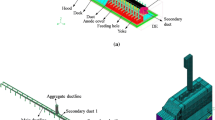Abstract
Problems associated with aluminium smelting cell ventilation, caused by leakage of fume gases through pots superstructure gaps into the potroom, are normally solved by increasing the fume suction rate (draught) above certain levels. It is also known that, fugitive emissions are associated with reducing the draught below certain critical levels. Top heat losses are increasing in smelting cells as line amperage is raised. This drives further fugitive emissions through greater buoyancy of the fume/air mixture. A quantitative understanding of the relationship between fugitive emissions, superstructure tightness, top heat loss, and cell draught is crucial in the environmental context. It is also important if this top heat loss could be recovered for re-use.
This problem is studied here computationally using the ANSYS-CFX software. Possibilities to improve cell ventilation and to decrease fugitive emissions are analysed for a typical industrial cell. The computed cell emissions and temperatures are compared with measured values. The impact of draught on ventilation and heat loss is also discussed
Access this chapter
Tax calculation will be finalised at checkout
Purchases are for personal use only
Preview
Unable to display preview. Download preview PDF.
Similar content being viewed by others
Reference
M.D. Gadd, Barry Welch, and A.D. Ackland. The Effect of Process Operations on Smelter Cell Top Heat Losses, Light Metals 2000 pp [231, 238].
Gadd, M.D., Aluminium Smelter Cell Energy Flow Monitoring, in Chemical and Materials Engineering. PhD thesis, 2003, The University of Auckland: Auckland, New Zealand.
Karlsen M., et al. Factors influencing cell hooding and gas collection efficiencies. Light Metals 1998 pp [303, 310].
Elaine Y.-L. Sum, Chris Cleary, and Tseng T. Khoo Understanding And Controlling Hf Fugitive Emissions Through Continuous Hf Monitoring And Air Velocity Characterisation In Reduction Lines. Light Metals 2000 pp [357, 364].
Dando N.R., and Tang R., Impact of Tending Practices on Fluoride Evolution and Emission from Aluminum Smelting Pots. Light Metals 2006 pp [203, 206].
Lindsay S.J. Effective Techniques to Control Fluoride Emissions. Light Metals 2007 pp [199, 203].
Al-Ojaimi H.H. Employees Behaviour In Improving Roof Emission In Reduction Potlines 1–3. in 9AASTC Proceedings 2007.
Xian Chun Shen, Margaret Hyland, and Barry Welch. Top Heat Loss In Hall-Heroult Cells. Light Metals 2008 pp [501, 504].
Y. A. M. Al Farsi, A. Meghlaoui, and N. Aljabri. Cd20 Reduction Cell Upgrade For Dubal’s Expansion Project. in TMS Aluminum Committee. Light Metals 2005 pp [297, 302]. San Francisco, California: TMS Aluminum Committee.
Perry R.H., and Green D. W., Perry’s Chemical Engineer’s Handbook. Vol. 6th edition. 1984: McGraw Hill.
Ketil A. Rye, Jomar Thonstad, and Xiaoling Liu. Heat Transfer, Thermal Conductivity, and Emissivity of Hall — Heroult top Crust. Light Metals 1995 pp [441, 449].
Kia Grjothem, and Barry Welch., Aluminium Smelter Technology. Vol. 2nd Edition. 1988: Aluminium Verlag.
M.P. Taylor, et al., Dynamic Model for the Energy Balance of an Electrolysis Cell. Trans IChemE 74, 1996. 74(Part A): p. 913, 933.
Biedler Philip, and L. Banta Analysis And Correction Of Heat Balance Issues In Aluminum Reduction Cells. Light Metals 2003 pp [441, 447].
Wesseling, P., Principles of Computational Fluid Dynamics. 2001.
Delsante A.E., and Clarke R.E., Measurements and calculations of temperature and heat transfer coefficients in an aluminium smelter potline. 1991, CSIRO Australia/Division of Building, Construction, and Engineering. DBCE Doc. 91/59 (M), report 236.
Holt N. J, et al., Ventilation of Potrooms in Aluminium Production. Light Metals 1999 pp [263, 268].
Lid, O. and Q. Haugen. Potroom Ventilation System by Segragated Air Layers. Light Metals 1984 pp [743, 753].
Frank P. Incropera, D.P.D., Introduction to Heat Transfer. Vol. Fourth Edition. 2002.
Author information
Authors and Affiliations
Editor information
Editors and Affiliations
Rights and permissions
Copyright information
© 2016 The Minerals, Metals & Materials Society
About this chapter
Cite this chapter
Abbas, H., Taylor, M.P., Farid, M., Chen, J.J.J. (2016). The Impact of Cell Ventilation on the Top Heat Losses and Fugitive Emissions in an Aluminium Smelting Cell. In: Bearne, G., Dupuis, M., Tarcy, G. (eds) Essential Readings in Light Metals. Springer, Cham. https://doi.org/10.1007/978-3-319-48156-2_62
Download citation
DOI: https://doi.org/10.1007/978-3-319-48156-2_62
Publisher Name: Springer, Cham
Print ISBN: 978-3-319-48155-5
Online ISBN: 978-3-319-48156-2
eBook Packages: Chemistry and Materials ScienceChemistry and Material Science (R0)




